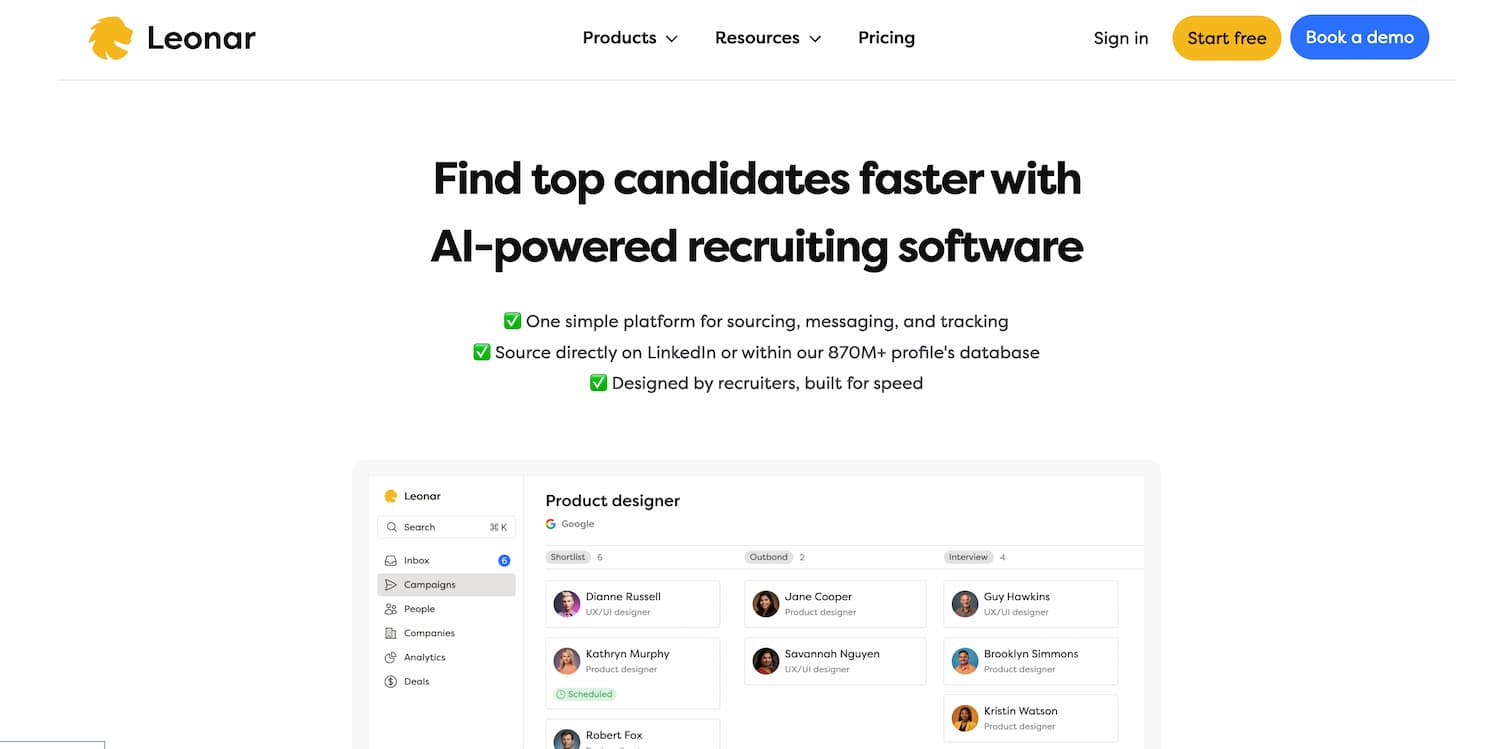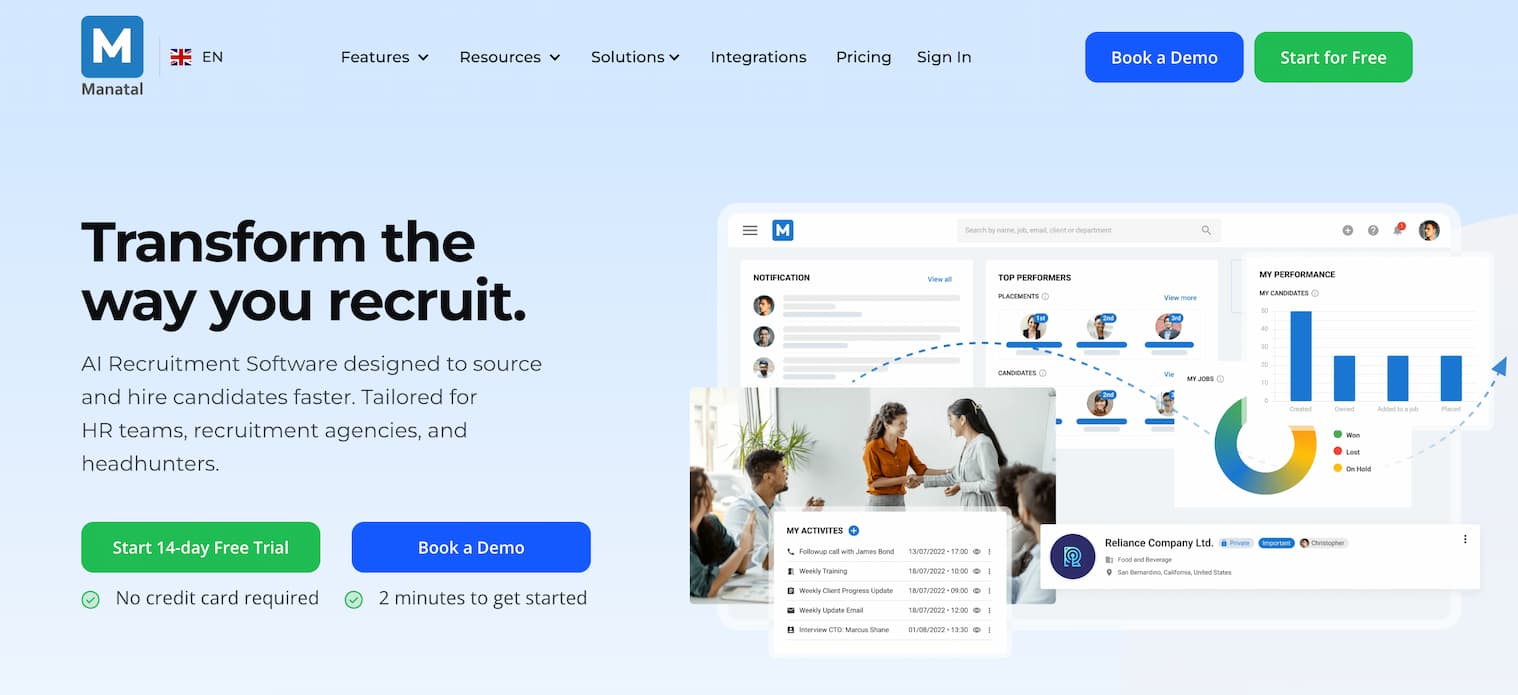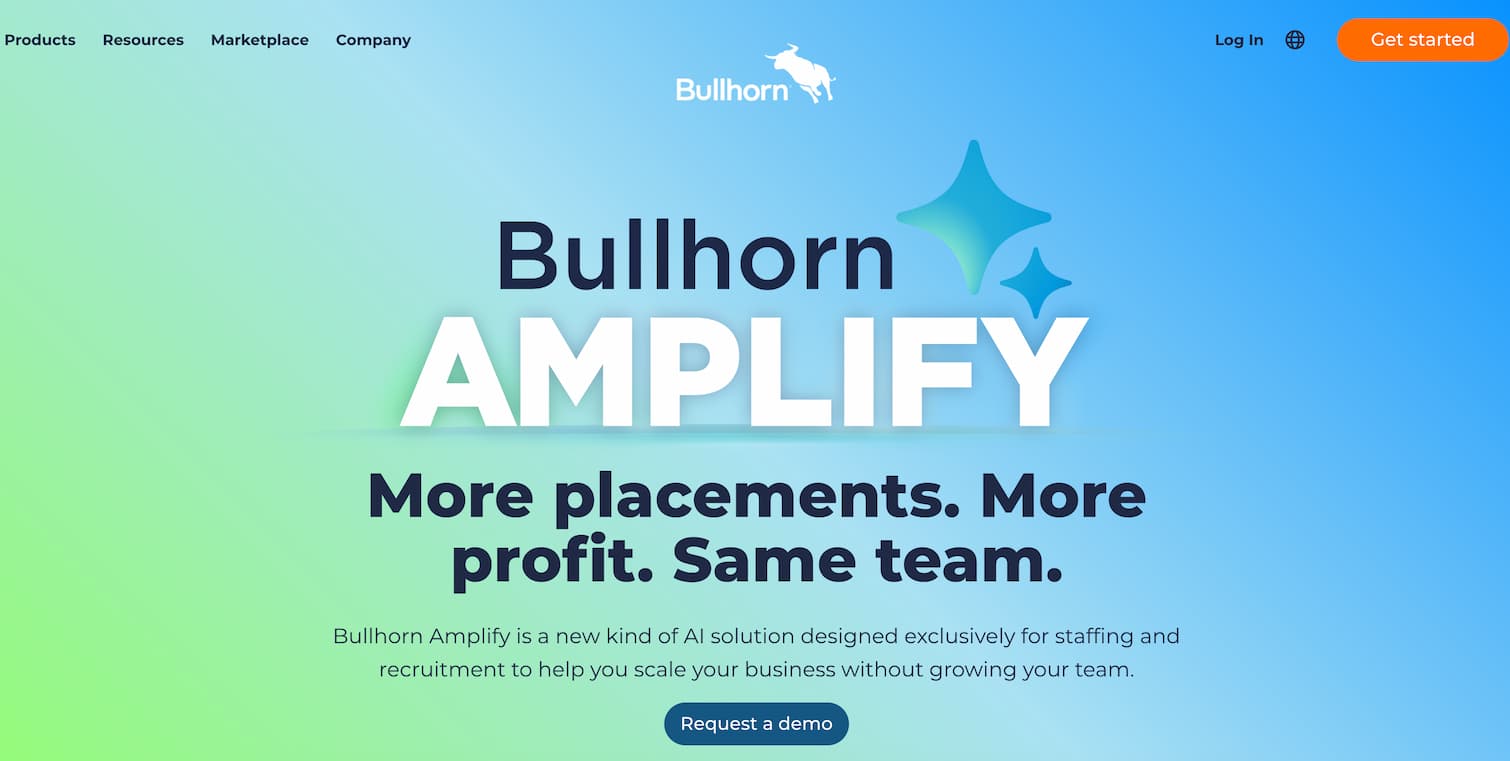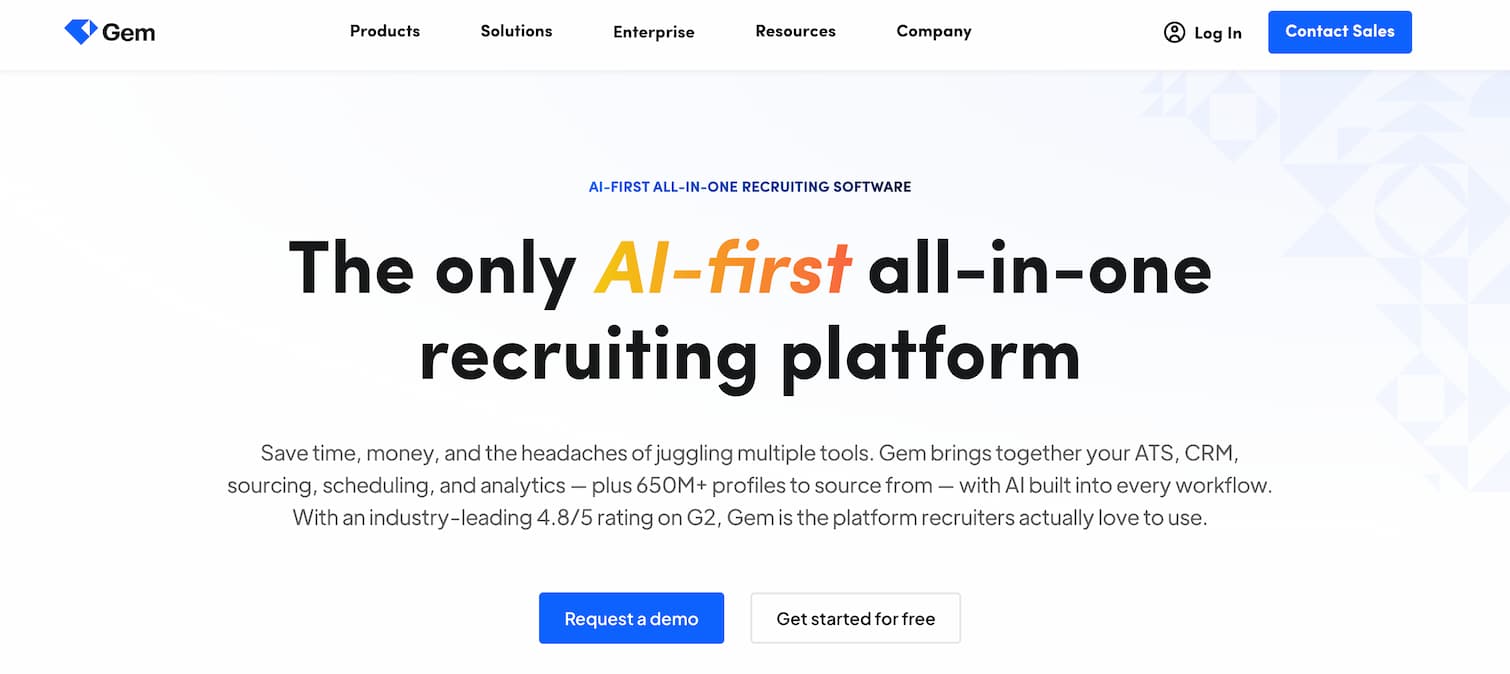Introduction: What is Loxo and what are its features?
Loxo positions itself as an easy-to-use recruitment platform. It is considered to be one of the most famous all-in-one recruitment tool, combining ATS, CRM and sourcing features. Instead of paying for a separate Applicant Tracking System (ATS), a sales CRM (like Salesforce), a sourcing tool (like LinkedIn Recruiter), and an email outreach tool, Loxo combines them into one unified platform.
Its platform is built on four main pillars:
- Applicant Tracking System (ATS): This is the core workflow engine. It manages your job pipelines, tracks candidates from first contact to placement, and handles the day-to-day administrative tasks of a recruiter.
- Recruiting CRM: Loxo includes a full-featured Customer Relationship Management (CRM) system. This is a crucial distinction, as it’s designed to manage relationships with both candidates (building talent pools) and clients (tracking business development). This is why it can be also used by recruitment firm.
- Loxo Source: This is Loxo's proprietary sourcing database. It claims to have over 1.2 billion professional profiles complete with contact information, designed to be a direct alternative to other third-party sourcing tools.
- Loxo Outreach: This is an automation tool that lets you build and send multi-channel outreach sequences (email, SMS, etc.) to candidates and prospects at scale.
Loxo can be used both by internal recruiters and recruitment agencies. However, although Loxo has many users around the world, more and more users are preferring to use other tools.
Understanding Loxo's Limitations: Where It Falls Short
While Loxo positions itself as an all-in-one solution, many users find it has significant limitations, particularly when it comes to proactive talent acquisition. A primary concern for growing agencies or early stage startups is the overall price point. The first price start at $169 per users while this pricing includes only basic features. Beyond the cost, users frequently report functional challenges that hinder daily workflow, such as persistent problems with email synchronization that can disrupt communication with candidates.
The most significant drawbacks center on sourcing. The outreach features are often described as limited, lacking the advanced sequencing and automation capabilities of specialized tools. This is closely related to the candidate database source, which feels restricted, especially when benchmarked against the comprehensive data available in LinkedIn Recruiter. The software doesn't always connect to LinkedIn very well, creating a disjointed process for recruiters trying to bridge the two platforms. Furthermore, the overall user experience (UX) can be difficult and present a steep learning curve, and when teams run into trouble, they have reported that the customer support is not always as responsive or helpful as needed.
These challenges lead many to a clear conclusion: Loxo functions as a good Applicant Tracking System (ATS) for managing candidates you already have, but it is not a great sourcing tool for finding new ones.
👉 Looking for the best ATS for your recruitment agency, check our blog post on the Best Applicant Tracking System for your recruitment agency.
Quick Comparison: Top 7 Loxo Alternatives
Top 7 All-in-One Loxo Alternatives (Full Replacements)
Leonar

Leonar is a powerful sourcing platform designed to fix Loxo's biggest weaknesses: its limited database and basic outreach. It is built for outbound recruiting and directly gives you access to a talent database of over 870 million profiles. This means you are no longer limited by your own network or a weak connection to LinkedIn.
Where Leonar truly shines is in its multi-channel outreach automation. Unlike Loxo's limited features, Leonar lets you build automated message sequences across LinkedIn, InMail, email, and even WhatsApp. It also finds candidate contact information like emails and phone numbers to make this possible. It's a great tool for both in-house teams and agencies, as it helps reduce sourcing time and increase response rates. Pricing starts with a Basic plan at $75 per user/month (billed annually), but the Professional plan at $119 per user/month is needed to unlock the AI sourcing database and full automation features.
👉Try Leonar with the Start free trial.
RecruitCRM
RecruitCRM is an all-in-one ATS and CRM built specifically for small to medium staffing and executive search firms. It's often chosen as a more cost-effective and user-friendly alternative to complex systems like Bullhorn. Its strengths lie in its core recruiting features: it includes a great Chrome extension for sourcing candidates from LinkedIn, automated resume parsing, and even includes GPT-4 features in all its plans. It also offers transparent pricing, with a Pro plan at €95 per user per month and a Business plan at €135 per user per month.
However, when comparing it to Loxo's specific weaknesses, it's a mixed bag. While users praise its ease of use and round-the-clock live support (a big plus over Loxo), it shares one of Loxo's biggest limitations: it does not have automated outreach sequences. It also has limited tools for interviewing and restricts the number of AI candidate matches in its lower-tier plan. RecruitCRM is a great, affordable option if your main problems with Loxo are poor support, a difficult UX, and a high price, but it will not solve your need for a powerful, automated sourcing tool.
Manatal

Manatal is a cloud-based ATS that is a fantastic Loxo alternative for teams frustrated by high costs and a difficult user experience. It is well-known for being affordable and very easy to use, featuring a simple drag-and-drop interface. Its core strength is using AI to make hiring simpler, offering recommendations to help you find the best candidates in your pool. It also helps with sourcing through a LinkedIn Chrome extension to easily gather profile information. You can then manage your applicants using clean Kanban boards and Boolean search.
While it’s a great tool, it does have a few limitations. The AI-matching features work best with English resumes, making it less accurate for other languages. It also lacks a wide range of pre-built integrations, which might be a problem for teams that rely on many other HR tools. Even so, it's a strong choice for companies that want a smart, simple ATS without Loxo's high price tag.
Bullhorn

Bullhorn is the market-leading for enterprise ATS software.. It is a solid choice for established staffing agencies or large companies that need one powerful tool to run their whole business. Its Applicant Tracking System (ATS) is very effective, helping you manage a candidate's entire journey from sourcing to placement. It also handles posting jobs to multiple platforms and gathering all the applications in one place. Plus, it includes strong client management and billing features, making it a true all-in-one solution for agencies.
However, Bullhorn has its own limits. If you think Loxo is expensive, Bullhorn is often much more so, with prices ranging from €1,200 to €6,000 per user, per year, which is a barrier for small teams. It also shares Loxo's "difficult UX" problem; the system is very complex and can be tricky for beginners to learn. And while it's a great ATS, its automation features are not as advanced as other modern tools, so it may not solve your sourcing outreach problems.
👉 Looking for more alternatives? Check our blog post: Bullhorn alternatives for recruiters.
Zoho Recruit

Zoho Recruit is a fantastic alternative for anyone frustrated by Loxo's high price and poor email synchronization. Its pricing is one of the most aggressive on the market, offering a "Forever Free" plan for single users and paid plans for agencies starting at just $25 per user per month (billed annually). The value is exceptional, packing in features that rival top-tier systems for a fraction of the cost. Because it's part of the massive Zoho ecosystem, its integration with tools like Zoho CRM and its native email/calendar functions are seamless, directly solving one of Loxo's biggest technical headaches.
Sourcewhale
.jpg)
Sourcewhale is a specialized tool that focuses on doing one thing perfectly: outreach. It is not a full-service ATS, so it doesn't replace Loxo's candidate-tracking features. Instead, it is a best-in-class "Recruitment Productivity Platform" that you add to your existing system to fix all of Loxo's sourcing and communication problems.
Its core strength is its powerful, multi-channel outreach automation. Where Loxo's outreach is basic, Sourcewhale lets you build advanced, automated sequences across Email, LinkedIn, SMS, and WhatsApp. It is built to live on top of platforms like LinkedIn, solving Loxo's poor integration, and has a data-finding module to find verified email addresses and phone numbers. It also directly fixes Loxo's user complaints: Sourcewhale is famous for its excellent, responsive customer support and its clean, easy-to-use interface. This is a premium tool—it is not cheaper than Loxo—but it is the perfect solution for agencies that need a powerful, reliable sourcing engine
👉 Looking to automate inmails? Check our blog post: How to automate inmail messages on Linkedin.
GEM

GEM is a top tool for finding candidates. It's built to fix Loxo's weak sourcing features. It works very well with LinkedIn, lets you send many follow-up emails and InMails automatically, and shows you how well your messages are working. If Loxo's outreach feels too basic, GEM gives you the advanced tools you need. Its biggest drawback is that it cannot automate LinkedIn messages, so your team will still have to send InMails one by one. It also doesn't have a single inbox for all your messages, making it tricky to manage replies. Other recruiters have noted it's difficult to upload large lists of candidates, and its high price can be a challenge for smaller recruiting teams.
👉 Looking for more alternatives? Check our blog post: GEM alternatives.
Conclusion: How to Choose Your Loxo Alternative
Choosing the right alternative to Loxo comes down to identifying its core weakness: Loxo is a good Applicant Tracking System (ATS), but it is not a great sourcing tool.
For recruitment agencies and teams whose primary bottleneck is finding new candidates, the solution isn't just a cheaper or easier-to-use ATS. The solution is a platform built for proactive, outbound recruiting. Leonar is the strongest all-in-one replacement. It directly solves Loxo's biggest sourcing weaknesses by providing a massive 870M+ profile database and true multi-channel outreach automation (LinkedIn, email, and WhatsApp).
If your main struggle is managing existing candidates, a simple ATS will do. But if you need to find new talent and replace Loxo's weak sourcing capabilities, you need a powerful sourcing platform like Leonar.


.svg)



